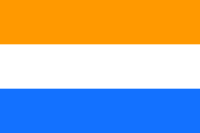| Jersey Dutch | |
|---|---|
| Laag Duits (Low Dutch) | |
 The Jersey Dutch, descendants of New Netherlanders. | |
| Region | New Jersey and New York, United States |
| Extinct | Early 20th century[1] |
| Latin (Dutch alphabet) | |
| Language codes | |
| ISO 639-3 | – |
| IETF | nl-u-sd-usnj |
| This article is a part of a series on |
| Dutch |
|---|
| Low Saxon dialects |
| West Low Franconian dialects |
| East Low Franconian dialects |
Jersey Dutch (Dutch: Laag Duits) (Low Dutch),[2][3][4] also known as Bergen Dutch,[5] was a Dutch dialect formerly spoken in northeastern New Jersey from the late 17th century until the early 20th century.[6] It evolved in one of the two Dutch-speaking enclaves that remained for over two centuries after the dissolution of Dutch control in North America, the other (around Albany, New York) giving rise to Mohawk Dutch.[7] It may have been a partial creole language[8][failed verification] based on Zeelandic and West Flemish Dutch dialects with English and possibly some elements of Lenape.[citation needed]
Jersey Dutch was spoken by the descendants of New Netherlanders who settled in Bergen, New Netherland, in 1630, and by Black slaves and free people of color also residing in that region, as well as the American Indian people known as the Ramapough Lenape Nation.
- ^ "Jersey Dutch, still spoken near New York a century ago | DUTCH the magazine". Archived from the original on 2016-12-23. Retrieved 2016-12-22.
- ^ Prince, John Dyneley (1910). The Jersey Dutch dialect. pp. 1–484. OCLC 68458100.
- ^ Prince, J. Dyneley (1910). "The Jersey Dutch dialect". Dialect Notes. 3: 459–484.
- ^ Nicoline van der Sijs (2009). Yankees, cookies en Dollars: De invloed van het Nederlands op de Noord-Amerikaanse Talen (in Dutch). Amsterdam University Press. pp. 25, 41.
- ^ Mencken, H.L. (1921). The American Language.
- ^ Shetter, William Z. (1958). "A Final Word on Jersey Dutch". American Speech. 33 (4): 243–251. doi:10.2307/453863. JSTOR 453863.
- ^ "When Did New York Stop Speaking Dutch?".
- ^ Holm, John A. (1989). Pidgins and Creoles. Cambridge University Press. pp. 335–8. ISBN 0-521-35940-6.